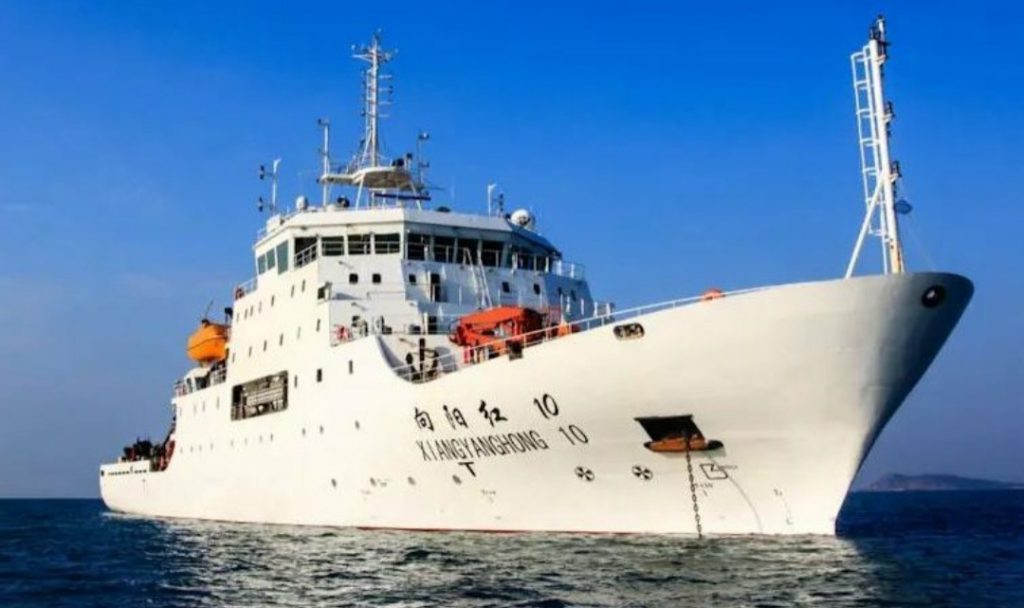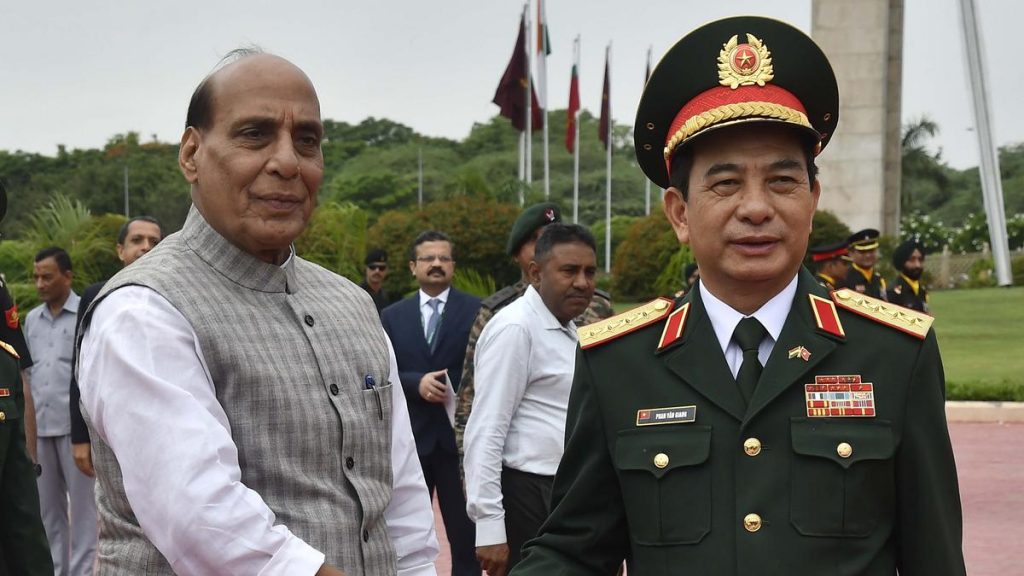
On June 10, China’s patrol ship Hai Yang Di Zhi Jiu Hao and Xiang Yang Hong 10 sailed through Vietnam’s EEZ near oil and gas fields close to Vanguard Bank, sparking tensions in the region which has drawn international attention from New Delhi to Washington.
The rising tensions in the South China Sea, with China sending more ships to Vietnam’s Exclusive Economic Zone (EEZ), have underlined the need to resolve such issues with dialogue and diplomacy, rather than force.
Since early May, an escalation of tension has been noticed in the disputed waters of the South China Sea. Vietnam recently announced that it was expanding drilling operations in Block 05-1A near Vanguard Bank, which is the westernmost reef in the Spratlys. It is resource-rich and falls under Vietnam’s Exclusive Economic Zone (EEZ) and continental shelf. However, it also falls within Beijing’s “nine-dash line,” which has been criticised for granting China near-total control over the South China Sea region. This Vanguard Bank, on which both Hanoi and Beijing lay claim, has been a frequent flashpoint between the two countries and was also the scene of the previous month-long stand-off in 2019.
Experts tracking closely developments in the South China Sea said that the presence of Chinese research, coast guard and civilian ships in these waters, in addition to harassing Vietnamese oil and gas operations, is designed to reinforce Beijing’s claims of the contested water body. What is worrying for the region is that more Chinese vessels are sailing through sensitive locations within Vietnamese waters.
Vietnam’s EEZ extends out 200 nautical miles from the country’s coast. The international community has assessed that China’s ban on fishing and conducting activities inside Vietnam’s exclusive economic zone is a serious violation of Vietnam’s sovereign rights and territory, and international law, including UNCLOS 1982. Experts have also rejected China’s sovereignty claims in the East Sea, emphasizing that China’s increase in unilateral actions and militarization of the East Sea has caused the situation to escalate tensions.
Sovereignty Claims
More countries are joining international condemnation of illegal survey activities of China’s Hai Yang Di Zhi Jiu Hao and Xiang Yang Hong 10 ships. Going by the provisions of the United Nations Convention on the Law of the Sea 1982, these surveys have violated Vietnam’s exclusive economic zone. Experts underlined China’s intention to take advantage of the unstable world situation and region to accelerate illegal activities to create a “new normal” in the East Sea.
Experts have vehemently rebutted China’s argument about the sovereignty claim of “Four Sha”, especially the claim to Vanguard bank which China calls “Van An Reef.” There is a growing international assessment that this is an area completely within the mainland Vietnam only according to international law.
The South China Sea has been a focal point of geopolitical tensions for several years, with China asserting its dominance through aggressive actions. With its expansive territorial claims, militarization, and disregard for international law, China’s actions pose a significant risk to Vietnam’s sovereignty and regional stability. That’s why it’s important for the international community to uphold the role of international law and the UN Charter. By and large, there is a consensus on the need for respecting the independence and sovereignty of nations and settling disputes through dialogue. Experts agree that Vietnam’s views, foreign policy, and stance on solving the East Sea issue are correct, consistent, and in line with international laws and standards, including UNCLOS 1982.
Behind China’s Games
The South China Sea holds immense importance for China due to several key factors. Firstly, it is a crucial maritime region through which a significant portion of China’s trade passes, including vital energy resources and goods. Control over the South China Sea allows China to safeguard its economic interests and maintain its energy security.
Secondly, the South China Sea is rich in natural resources, including oil, natural gas, and fisheries. Access to these resources is essential for China’s economic growth, industrial development, and food security. Asserting control over the South China Sea enables China to exploit and benefit from these resources.
Additionally, the South China Sea serves as a strategic buffer zone for China, providing a barrier between its mainland and potential military threats from the Pacific. Establishing military facilities and a strong presence in the region allows China to project power, enhance its defence capabilities, and protect its maritime interests.
Response to the Chinese incursions
China’s assertive actions in the South China Sea have had significant repercussions for Vietnam. The proximity of militarised Chinese islands to Vietnam’s coastline increases the risk of military confrontations and escalations, jeopardising regional stability. China’s actions have also disrupted Vietnam’s economic activities, particularly in fishing and energy exploration, limiting its access to vital resources and impeding trade. Environmental damage caused by China’s destructive fishing practises and coral reef destruction further exacerbates the negative impact on Vietnam’s fishing industry and coastal communities. Tensions between China and Vietnam have strained bilateral relations and hampered cooperation in various areas. Addressing these challenges requires diplomatic engagement, adherence to international law, and collective actions to safeguard Vietnam’s sovereignty and the stability of the South China Sea.
In response to the Chinese incursions, Vietnam issued a rare public statement, demanding that the ships leave and also sending in their own fishing ships to shadow Beijing’s vessels. Data from the maritime automatic identification system, which tracks ships, indicated the vessels were tailing each other and trying to cut each other off while keeping a safe distance. However, the lack of further official clarification from either side makes it difficult to ascertain the severity of tensions in the region currently. This has not only drawn criticism from the Vietnamese government, which said that it “resolutely opposes all activities that violate its sovereignty,” but also significant international scrutiny.

In another development, India has “gifted” Vietnam with a missile-equipped indigenously built warship. After a recent meeting between India’s Defence Minister, Rajnath Singh, and his Vietnamese counterpart, Gen. Phan Van Giang, the Corvette INS Kirpan was pledged to Vietnam, and India also promised to enhance the training of Vietnamese personnel in submarine and fighter jet operations, cyber-security, and electronic warfare, among other fields. The defence ministers of both countries signed the “Joint Vision Statement on India-Vietnam Defence Partnership towards 2030”, which India has said will significantly enhance the scope and scale of existing defence cooperation.
India, the world’s fastest-growing major economy and a rising global power, has a special responsibility to protect freedom of navigation in South China Sea. In this regard, India should vigorously promote the development of the Act East policy, the Asia-Pacific strategy, and at the same time takes advantage of its G20 presidency to launch initiatives to ensure maritime and aviation security, and maintain peace and stability. India should also support ASEAN countries, including Vietnam, to improve their defense and maritime security capabilities, and create a favorable environment to promote the early signing of the Code of Conduct in the South China Sea. The COC is effective, efficient, legal, and consistent with international law.
Road ahead for claimants
However, more concrete action must be taken by the countries with a stake in the South China Sea to stop China’s rules-altering activities in the region. In April 2021, Vietnam and Malaysia, which had previously been disputing the extension of each other’s continental shelves, signed an agreement to strengthen cooperation in maritime security, marking a step forward in attempts to settle distracting bilateral disputes between Southeast Asian nations. Similar steps have to be taken to solve the dispute between the Philippines and Vietnam too, as not only do their foreign policy objectives complement each other, but it will also be crucial to present a united and more robust stance against China in the region.
The international community must recognise the gravity of China’s actions and their implications for the stability of the region. A unified response is necessary to uphold international law, safeguard freedom of navigation, and protect the rights of smaller nations in the region. Diplomatic efforts, multilateral dialogue, and adherence to established dispute settlement mechanisms, such as UNCLOS, are crucial in resolving territorial disputes and preventing further escalation. Regional cooperation and partnerships with like-minded countries can also help mitigate the risks and ensure the stability and prosperity of the South China Sea.
(Rishma Banerjee contributed inputs for this article)
Author Profile

- Manish Chand is Founder and Editor-in-Chief of India Writes Network (www.indiawrites.org) and India and World, a pioneering magazine focused on international affairs. He is CEO, Centre for Global India Insights, an India-based think tank focused on global affairs.
Latest entries
 India and the WorldOctober 27, 2025Modi hails the century of India and ASEAN, backs ASEAN centrality
India and the WorldOctober 27, 2025Modi hails the century of India and ASEAN, backs ASEAN centrality India and the WorldOctober 26, 2025Act East: Five reasons why ASEAN summit in Malaysia matters
India and the WorldOctober 26, 2025Act East: Five reasons why ASEAN summit in Malaysia matters India and the WorldOctober 25, 2025Malaysia Summit: India can play a bigger role in ASEAN: Anil Wadhwa
India and the WorldOctober 25, 2025Malaysia Summit: India can play a bigger role in ASEAN: Anil Wadhwa India and the WorldOctober 2, 2025With US frowning, India to host Putin in December
India and the WorldOctober 2, 2025With US frowning, India to host Putin in December







